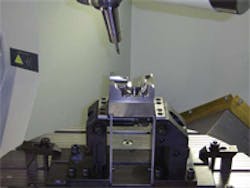Shops constantly face challenges to be more productive and to drive down production costs. And, in many cases, to meet these goals, they are using workholding devices more creatively, rather than buying new equipment.
Steve Kane, sales and marketing manager at Kurt Manufacturing (www.kurtworkholding.com) identified three significant trends that are driving the technologies of workholding:
• First, to achieve higher productivity. Shops are adopting standard and custom designs that allow them to decrease set up times while they increase the density — more parts on a single fixture — of workholders..
• Second, modular workholding devices and quick-change, zeropoint clamping systems that integrate with new or existing workholding devices are becoming more common for smaller parts.. These systems locate parts very accurately and provide fast, highly accurate setup on machining centers, usually within 0.0002 in. And, these systems help to eliminate time-consuming setup, alignment and boltdown tasks.For example, one system consists of a hydraulically actuated locking cylinder that positions and locks the vise or fixture onto the machine worktable. It allows the user to locate or to remove the workholding fixture from a machine, or to move it offline or to another machine and back again in seconds with zero-point positioning accuracy.
• The third trend impacting workholding is that five-axis machining is becoming more common, especially in the mold and die industry, and that is allowing five sides of a part to be machined in one setup. The spindles on many of these machine tools are large, and the challenge becomes how to hold a part on the worktable while providing spindle clearance and holding the part securely.
For such five-axis machining needs, Kurt has developed the VB 5AX100 Schenke Clamping System that can be mounted on Tslot or location-grid machine tables or on a custom fixture.
The system has a high clamping force (to 40 kN) and incorporates a tension spindle directly below the workpiece support. The jaws do not flare out under tension so the machine table is not distorted. With a clamping depth of 8 mm, the system permits obstruction free machining on five sides of a part. The system clamps blank or machined workpieces, and round and irregularly formed workpieces.
Another developing workholding technology that allows maximum workpiece accessibility is lightactivated adhesive gripping.
In this process, an ultraviolet light cures a strong adhesive that provides fast, effective bonding of parts for machining. This technique eliminates the need for hydraulic or pneumatic clamping, and eliminates the potential for part distortion that can arise from compressive forces.
In an effort to reduce labor costs, more shops are using automated systems that involve pallet pools that are designed for multiple machines served by robotic loading and unloading equipment.
In such systems, the workholding, robotics and gauging systems are integrated, and they are controlled automatically.
Kane said that developing an automated system requires fresh and different workholding concepts.
For example, an operator can tell when a part is properly loaded and clamped, but a robot can only take a picture of the process. Adjusting for such differences requires changes in workholding devices, and could call for the use of double-acting hydraulics, rather than the single-acting hydraulic systems used in operatorcontrolled systems.
